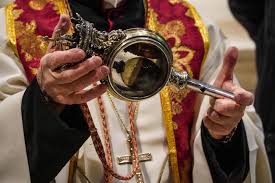Blood of Naples saint Gennaro liquefies in recurring ‘miracle’

The dried blood of Naples’ third-century patron saint Gennaro liquefied at the city’s cathedral on Saturday evening, in a recurring ‘miracle’ 17 centuries after the martyr’s death.
The reputed miracle was announced at exactly 18.38 by Abbot Vincenzo De Gregorio, as the archbishop of Naples Domenico Battaglia held aloft the glass ampoule to demonstrate the blood’s liquid state.
The news, accompanied by the traditional waving of a white handkerchief, was welcomed by lengthy applause from the faithful gathered inside and outside the Basilica di Santa Chiara.

The recurring event occurs on three dates every year: 19 September (the saint’s feast day), 16 December and the first Saturday in May.
On each occasion the faithful gather in the southern Italian city to witness the liquefaction of what is claimed to be a sample of S. Gennaro’s blood, kept in a sealed glass ampoule.
Three times a year this vial of dried blood is exposed for public veneration, with the “relatives” of S. Gennaro – a group of elderly faithful – chanting litanies and prayers in a tradition dating back to the 19th century.
Who was S. Gennaro?
S. Gennaro, or St Januarius, was a bishop of Benevento in the third century, whose bones and blood are preserved as relics at the cathedral in Naples.
He is believed to have been martyred by beheading during the Christian persecution under Emperor Diocletian around 305 AD.
Legend has it that when Gennaro was beheaded, a Neapolitan woman soaked up his blood with a sponge and preserved it in a glass phial.
According to local lore, if the blood of S. Gennaro fails to liquefy it signals imminent disaster including war, famine or disease.
The blood failed to liquefy on 16 December 2020, on the eve of the covid pandemic, in what was seen by some as an omen of bad things to come.
Two months after the blood failed to liquefy on 19 September 1980, Irpinia – located 50 km east of Naples – was hit with a devastating earthquake that killed almost 3,000 people.
On previous – but not all – occasions when the blood failed to liquefy on the saint’s feast day, it signalled bad news for Naples.
The miracle also did not occur in 1939 and 1940, coinciding with the beginning of world war two and Italy’s entry into the conflict, and again in September 1943: the date of the Nazi occupation.
Neapolitans have traditionally turned to their patron to protect them from natural disasters – according to the Italian bishops’ newspaper Avvenire – with crowds of people in the early centuries seeking refuge in the catacombs of Capodimonte.
So it happened in 472, 512 and 685, with the Neapolitan bishops of the time leading the prayers of the people.
It then became customary to invoke S. Gennaro to ask for an end to volcanic eruptions: in 1631, on 16 December, it was decided to exhibit the relics and the eruption of Vesuvius stopped.
The Catholic Church has always supported the celebrations but has never formulated an official statement on the ‘miracle’.
However it does not permit the sealed vial to be opened which has hampered scientific research into the phenomenon.
The blood did not melt during the visits of Pope John Paul II in 1990 or Pope Benedict XVI in October 2007 – reports Avvenire – however it did liquefy when Pope Francis visited in March 2015.





